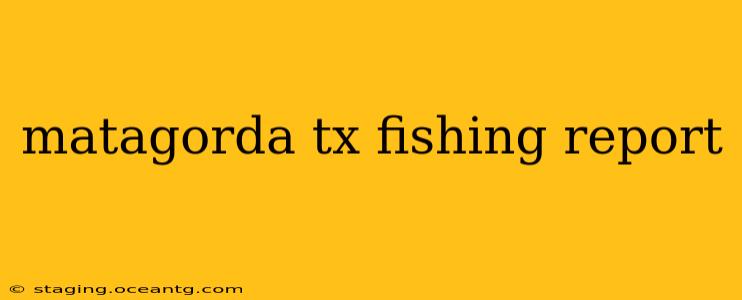Matagorda Bay, located along the Texas coast, is a renowned fishing destination boasting diverse species and exciting angling opportunities. This comprehensive fishing report provides up-to-date information and insights to help you plan your next fishing trip. We'll cover everything from current conditions and hot spots to target species and fishing techniques.
What's biting in Matagorda Bay right now?
This is the million-dollar question for any angler! The best way to answer this is to check local fishing reports closer to your trip. Conditions change daily, even hourly, in Matagorda Bay. Websites dedicated to Texas fishing, local tackle shops, and charter boat captains are excellent resources. They provide real-time updates on what species are actively feeding and where. Generally, Matagorda Bay offers a fantastic variety throughout the year, including:
- Summer: Redfish, speckled trout, flounder, and black drum are common catches during the summer months. Inshore areas tend to be productive.
- Fall: As water temperatures cool, fishing can become even better. Expect strong catches of redfish and speckled trout, with flounder still in the mix.
- Winter: While some species slow down, black drum fishing can be excellent during the colder months. Sheepshead are also a popular winter target.
- Spring: Spring brings warmer waters and increased activity. Speckled trout and redfish spawn, making them readily available.
Remember to always check the most recent reports before heading out.
What are the best fishing spots in Matagorda Bay?
Matagorda Bay is vast, offering numerous productive fishing spots. The best locations depend heavily on the current conditions and the species you're targeting. However, some consistently popular areas include:
- San Antonio Bay: Known for its shallow waters and abundant grass beds, providing excellent habitat for speckled trout and redfish.
- Pass Cavallo: This area offers a mix of shallow and deeper water, attracting a variety of species. Look for channels and oyster reefs.
- Espiritu Santo Bay: Another excellent spot for speckled trout and redfish, with various depths and habitats.
What is the best time of day to fish in Matagorda Bay?
The optimal fishing time often coincides with tidal changes. Incoming and outgoing tides create movement in the water, attracting baitfish and consequently, the predatory fish you're targeting. Dawn and dusk are also generally excellent times to fish, as the lower light levels can make fish less wary.
What type of fishing license do I need for Matagorda Bay?
You'll need a valid Texas fishing license. The Texas Parks and Wildlife Department website provides detailed information on licensing requirements and how to obtain one. Be sure to check the regulations before you go, as there may be size and bag limits for certain species.
What kind of bait should I use in Matagorda Bay?
The best bait depends on the target species. Popular choices include:
- Live shrimp: An excellent all-around bait for speckled trout, redfish, and flounder.
- Live croakers: Effective for larger redfish and black drum.
- Artificial lures: Topwater plugs, soft plastics, and spoons are all popular choices for many species. Experiment to see what works best on your fishing trip.
What are the current weather conditions in Matagorda Bay?
Checking the weather forecast before heading out is crucial for safety and success. Wind, rain, and temperature can significantly impact fishing conditions. Websites and apps dedicated to marine weather forecasts are essential tools for planning your trip.
What are the typical fishing techniques used in Matagorda Bay?
The techniques used will also vary based on target species and conditions. However, some common methods include:
- Light tackle fishing: This is popular for speckled trout and redfish, utilizing smaller rods, reels, and lures.
- Jigging: Effective for attracting bottom-dwelling species like flounder and black drum.
- Drift fishing: This method allows you to cover more ground and search for fish actively feeding.
This report provides a general overview. Remember to consult up-to-date information from local sources for the most accurate and timely fishing information. Tight lines!
